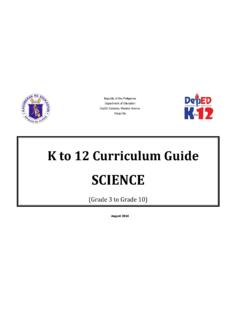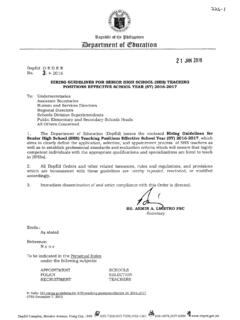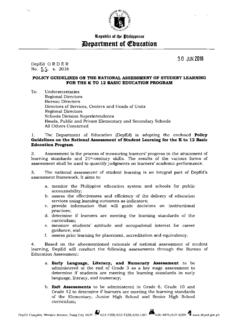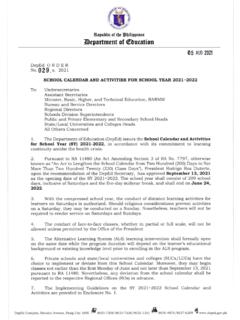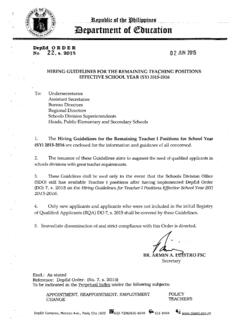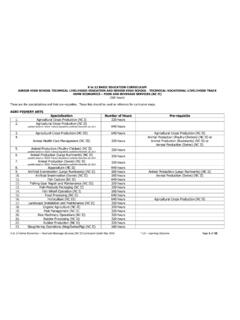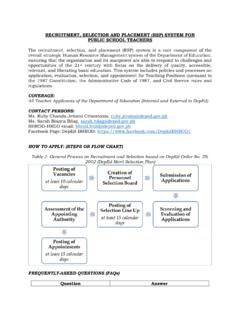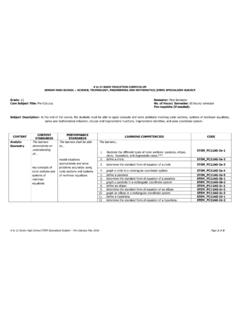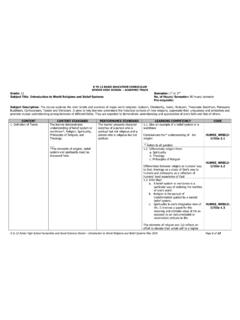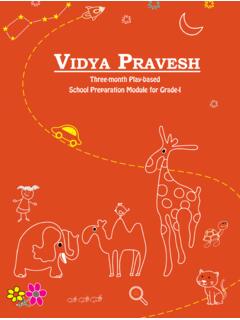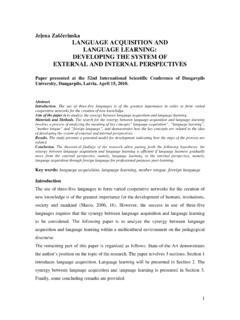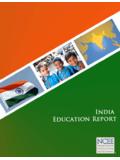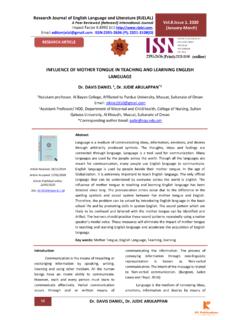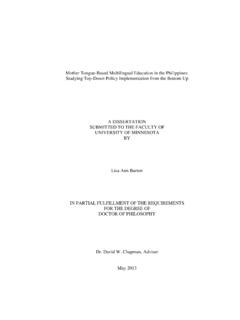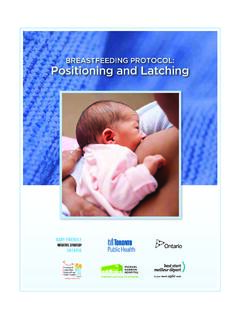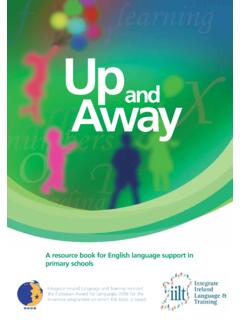Transcription of K to 12 Curriculum Guide - Department of Education
1 Republic of the Philippines Department of Education DepEd Complex, Meralco Avenue Pasig City May 2016 K to 12 Curriculum Guide mother tongue (Grade 1 to Grade 3) K to 12 BASIC Education Curriculum K to 12 mother tongue Curriculum Guide May 2016 Page 2 of 155 MTBMLE Curriculum FRAMEWORK Introduction mother tongue Based Multilingual Education (MTB-MLE) is the government s banner program for Education as a salient part of the implementation of the K to 12 Basic Education Program. Its significance is underscored by the passing of Republic Act 10523, otherwise known as the Enhanced Basic Educatiion Act of 2013.
2 MTBMLE is Education , formal or non - formal, in which the learner s mother tongue and additional languages are used in the classroom. Learners begin their Education in the language they understand best - their mother tongue - and develop a strong foundation in their mother language before adding additional languages. Research stresses the fact that children with a solid foundation in their mother tongue develop stronger literacy abilities in the school language. Their knowledge and skills transfer across languages. This bridge enables the learners to use both or all their languages for success in school and for lifelong learning .
3 In terms of cognitive development, the school activities will engage learners to move well beyond th basic wh-questions to cover all higher order thinking skills in L1 which they can transfer to the other languages once enough Filipino or English has been acquired to use these skills in thinking and articulating thoughts. With the nd goal of making Filipino children lifelong learners in their Li (MT), L2 (Filipino, the national language), and L3 (English, the global language) the learners are more thatn prepared to develop the competencies in the different learning areas. This will serve as their passport to enter and achieve well in the mainstream educational system and in the end, contribute productively to their community and to the larger society as well as Multilingual, Multiliterate, and Multi-Cultural Citizens of the country.
4 For the effective implementation of the MTB-MLE, it is suggested that the two-track method be used, that is the primer track to focus on accuracy and the story track to focus on meaning. learning via the two-track method to gain proficiency in leteracy as well as comprehend academic content and gain Curriculum mastery, creative and critical thinking skills for decisive decision-making. MTBMLE provides: Literacy. We only learn to read once. learning to read in the L1 develops skills that transfer to reading any other languages. Comprehension in reading other languages only occurs after oral proficiency has developed such that vocabulary of the written L2 text is already part of the learners spoken vocabulary.
5 Prior knowledge. Engaging learners in a discussion of what is already familiar to them using the home language and culture enables better learning of the Curriculum through integration and application of that knowledge into current knowledge schemes. Cognitive development and higher order thinking skills (HOTS). Using the learners mother tongue provides a strong foundation by developing cognitive skills and comprehension of the academic content from day one. The knowledge, skills, attitudes, and values gained through the mother tongue better support learning of other languages and learning through other languages later.
6 O As learners articulate their thoughts and expand ideas, both language and critical thinking are strengthened. MTBMLE cultivates critical thinking through talking about ideas in the familiar language. When teaching only in the L2, critical thinking is postponed until L2 is sufficiently developed to support such analysis. K to 12 BASIC Education Curriculum K to 12 mother tongue Curriculum Guide May 2016 Page 3 of 155 Strong Bridge. MTBMLE provides a good bridge to listening, speaking, reading, and writing the L2s (L2, L3) of the classroom using sound educational principles for building fluency and confidence in using the other languages for lifelong learning .
7 Reading in the L2 is only introduced after basic L1 reading fluency and L2 oral proficiency are developed. Comprehension in reading the L2 occurs after the development of that spoken L2. Once sufficient oral and written proficiency in the L2 are developed, a gradual transition to using the L2 as medium of instruction can progress without the L1 support. Scaffolding. In L2 teaching, the L1 is used to support learning when the L2 is not sufficiently developed to be used alone. The L1 is used for expression and the teacher facilitates the development of the L2 to enable learners to adequately express ideas in the L2.
8 In this way, the L1 strengthens the learning of the L2 by supporting the L2 development for communication. Teaching for meaning and accuracy. Decoding text requires accuracy, while comprehending texts requires decoding skills within a meaningful context. Both meaning and accuracy are important, but in classrooms that teach only L2 , there is often primary focus on accuracy until the L2 is sufficiently learned. This delays actual meaningful learning until the L2 can support that learning . Confidence building and proficiency development for two or more languages along the following macro-skills ( listening, speaking, reading, writing, and viewing ) for both meaning and accuracy.
9 K to 12 BASIC Education Curriculum K to 12 mother tongue Curriculum Guide May 2016 Page 4 of 155 K to 12 BASIC Education Curriculum K to 12 mother tongue Curriculum Guide May 2016 Page 5 of 155 The following standards illustrate teaching for meaning and accuracy: Listening Speaking Reading Writing Viewing Story track Focus on meaning Listen in order to understand, think critically respond creatively Speak with understanding, to communicate knowledge, ideas, experiences Read with understanding to apply, analyze, evaluate, and to create new knowledge Write to communicate knowledge, ideas experiences, goals View in order to understand, think critically respond creatively Primer track Focus on correctness Recognize and distinguish sounds.
10 Recognize parts of words Use correct vocabulary, pronunciation, grammar Decode by recognizing parts of words, sentences Form letters properly and neatly; spell words accurately; use correct grammar Recognize and distinguish print and non materials and be able to critic the materials objectively. K to 12 BASIC Education Curriculum K to 12 mother tongue Curriculum Guide May 2016 Page 6 of 155 GUIDING PRINCIPLES FOR TEACHING AND learning IN MTBMLE Principle 1. Known to the unknown learning requires meaning. We learn when we use what we already know to help us understand what is new.

